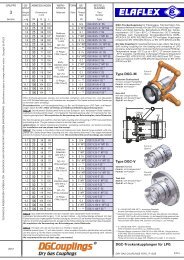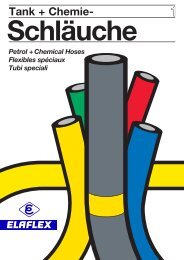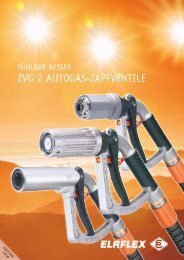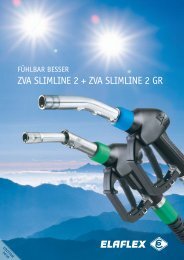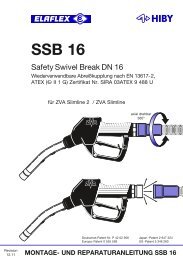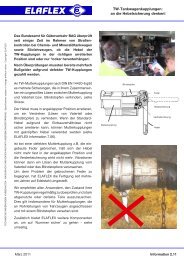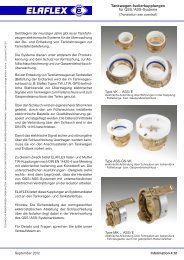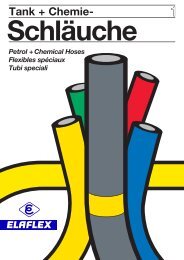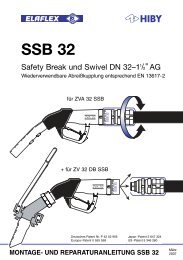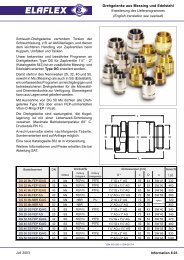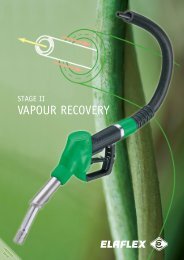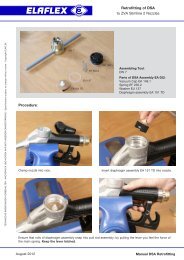Sie wollen auch ein ePaper? Erhöhen Sie die Reichweite Ihrer Titel.
YUMPU macht aus Druck-PDFs automatisch weboptimierte ePaper, die Google liebt.
Systemvergleich für SAFETY BREAKSWelche Abreißkupplung ist für mich die Richtige?(Translation see overleaf)Nach spektakulären Wegfahrunfällen mit Großschäden ist das Interesse an SAFETY BREAKS enorm gestiegen.In England sind solche selbstschließenden Abreißkupplungen seit vielen Jahren behördlich vorgeschrieben.In der EuroNorm EN 13617-1999 werden die Abreißkupplungen je nach der Einbausituation unterschieden inNozzle Breaks (am Zapfventil), Pump Breaks (an der Zapfsäule) und Hose Breaks (in der Schlauchleitung).Außerdem wurden die Sicherheitanforderungen festgelegt. Mit dieser Druckschrift soll eine Entscheidungshilfefür die richtige Wahl gegeben werden.1) Nozzle Breaks sitzen im Zapfventil oder direkt amZapfventilanschluß. Sie haben den Vorteil, daß nurein Sicherheitsventil erforderlich ist, weil <strong>bei</strong> einemAbriß nur die Schlauchseite abgedichtet werdenmuß. Dadurch sind sie kürzer, leichter und auchpreisgünstiger. <strong>ELAFLEX</strong> nutzt diesen Vorteil, umsie mit einem Axialswivel zu kombinieren. Der SafetySwivel SSB 16 öffnet nicht nur in dem vorgeschriebenenWinkelzugbereich von plus/minus 30°, sondernbis nahezu 90°! -Durch den SSB 16 werdenvorhandene Schlauchleitungen nur 25 mm länger.Der SSB 16 von <strong>ELAFLEX</strong> ist in Verbindung mit demZVA für alle Bauarten von Zapfsäulen geeignet.2) Pump Breaks werden direkt an die feste Rohrleitungder Zapfsäule angebaut. Diese Type istweniger im Gebrauch. Voraussetzung für denAnbau dieser Abreißkupplung ist eine ausreichendeFestigkeit der Zapfsäulenkonstruktion. Die sichergebende Verlängerung der starren Anbauachseum ca. 100 mm erhöht <strong>bei</strong> dem in der Praxis möglichenWinkelzug von ca. 1500 N die Beanspruchungdes Anschlußnippels und der Rohrleitungsbefestigungerheblich. Siehe Warnhinweise unten.Diese Type ist nicht geeignet für Federmast–Zapfsäulenund für MPDs mit Schlauchrückholung.3) Hose Breaks sind in die Schlauchleitung eingebautzwischen zwei Schläuchen, von denen derkurze Schlauch mindestens 150 mm lang sein muß.Diese Type ist in den USA stark verbreitet für diehoch oben befestigten Schläuche. Sie besitzen wiedie Pump Breaks selbstschließende Ventile nach<strong>bei</strong>den Seiten und sind daher länger und schwerer.Kostenmäßig wirkt sich außerdem nachteilig aus,daß für das kurze Schlauchstück zwei zusätzlicheSchlauchkupplungen erforderlich sind. Außerdemwird oft vermerkt, daß das Erscheinungsbild einermodernen Zapfsäule durch diese Type etwas beeinflußtwird. Hose Breaks sind nicht gut geeignet fürMPD-Zapfsäulen mit Schlauchrückholeinrichtungenund für Federmastsäulen.Warnhinweis: Bei nachträglichem Einbau vonAbreißkupplungen muß geprüft werden, ob Schaugläser,COAX-Anschlüsse u.ä. der <strong>bei</strong> einem Abrißauftretenden Zugbelastung gewachsen sind.Die auf diese Teile wirkenden Winkelzugkräfte werdenz.B. <strong>bei</strong>m Pump Break durch den um 100 mmlängeren, starren Hebelarm enorm verstärkt.Die Zugkraft auf die Abreißkupplung darf in allenmöglichen Wegfahrrichtungen nicht durch Pfeiler,Poller oder Werbeträger gebremst werden.Jede <strong>ELAFLEX</strong>-Abreißkupplung wird mit einerelastischen Breaktülle BT geliefert. Im Abrißfallbleibt die Schutztülle auf der Kupplungsseite, diedurch die Überdehnung des Schlauches zurückschnellt.Neben der Standardfarbe schwarz ist dieBreaktülle auch in blau, gelb, grün und rot (sieheAbbildung) lieferbar. Dadurch wird an der Zapfsäuleeine Produktkennzeichnung oder aber die Darstellungder Firmenfarbe ohne Mehrkosten ermöglicht.Druckschriften für Nozzle Breaksdie <strong>bei</strong> <strong>ELAFLEX</strong> angefordert werden können:● Safety Swivel Break SSB 16 (für DN 16+19)● ES-Break Doppelswivel ESB 16 (für DN 16+19)● COAX-Safety Break CSB 21 (Für Gasrückführung)● Safety Swivel Break SSB 32 (für DN 32+38)August 2000 Information 3.2000
Comparison of Safety Break TypesWhich type is the approriate one?After several spectacular drive-away accidents with considerable damage the interest in break-away couplingshas increased heavily. In the UK self-closing break-away couplings are required by the authorities since years.The European Standard EN 13617-1999 distinguishes (depending on their installation) nozzle breaks (at thenozzle), pump breaks (at the pump) and hose breaks (in the hose assembling). Additionally safety requirementsare laid down in the Standard. With this information we intend to give you some assistance for your right decision.1) Nozzle Breaks are either integrated in the nozzleor fitted directly into the nozzle inlet. Theadvantage is that only one valve is neededbecause only the hose side has to be closed incase of a break-off. Therefore, the nozzle breaksare shorter, lighter and less expensive.<strong>ELAFLEX</strong> is using this advantage to combinethem with an axial-swivel. The safety swivel SSB16 not only separates within the standardizedangle range of approx. plus/minus 30° but nearlyup to 90°. By the installation of the SSB 16 thehose assemblies are prolonged by 25 mm only.The nozzle break SSB 16 combined with theZVA nozzle is suitable for all kinds of petroldispensers.2) Pump Breaks are fitted directly to the rigid pipeof the dispenser. This type is less in use. A solidconstruction of the dispenser is necessary forthe connection with this break type. When apump break is fitted a prolongation of the rigid fittingconnection of about 100 mm results. Thenormally applied angle pull of about 1500 Nincreases therefore the load on the connectingnipple and on the pipe attachment.This type isnot usable for spring mast dispensers and MPDswith hose retraction.3) Hose Breaks are assembled between twohoses of which the shorter one has to be at least150 mm long. This type is mostly propagatedwith high hose dispensers in the USA. Like thepump breaks they have self-closing valves onboth ends. Therefore, they are longer and heavier.Concerning cost it is a disadvantage as theshort hose piece has to be fitted with two additionalhose couplings. Above that the appearanceof a modern dispenser may be impaired by thistype of break. Hose breaks cannot be recommendedfor MPDs with hose retraction and forspring mast pumps.Warning: In case of retro-fitting of break-awaycouplings it has to be checked whether sight glasses,COAX hose connections etc. are suitable towithstand the pull-off force in case of a breakoff. Incase of a pump break installation the effect of theangular pulling forces acting on these componentsis increased considerably by the approx. 100 mmlonger rigid leaver arm. Pillars, bollards or advertisingboards may not hinder the break-away couplingto be pulled in the direction of the driving off car.Every <strong>ELAFLEX</strong> break-away coupling is deliveredwith the break sleeve BT. In case of break-off thesleeve remains on the side of the hose coupling thatjumps back because of the over-extension of thehose. Besides the standard colour black the sleeve isalso available in blue, yellow, green and red (see drawing).This allows a product identification at thedispenser or a presentation of company's colourwithout extra charge.Following leaflets about Nozzle Breakscan be called off from <strong>ELAFLEX</strong>:● Safety Swivel break SSB 16 (for DN 16+19)● ES-Break Double Swivel ESB 16 (for DN 16+19)● COAX Safety Break CSB 21 (for vapour recovery)● Safety Swivel Break SSB 32 (for DN 32+38)<strong>ELAFLEX</strong>–Information 3.2000



